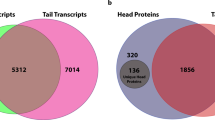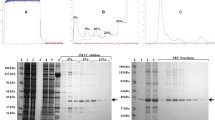Abstract
We present an analysis of the expression profile of Schistosoma japonicum cercariae by a strategy based on expressed sequence tags (ESTs). A cDNA library from S. japoniucm cercariae was constructed and was used to generate ESTs. In total, 201 clones randomly selected from the library were sequenced; 136 ESTs were successfully obtained and sent to the BLAST server for homology searching. Among the 136 ESTs, 85 (62.50%) did not match any protein or gene sequence published in the BLAST databases; these comprised 75 (55.15%) ESTs matched (or partly matched) S. japonicum and Schistosoma mansoni ESTs, 4 (2.94%) matched human ESTs and 6 (4.41%) that did not match any sequence. Fifty-one (37.50%) ESTs were identified by the BLAST server; these consisted of 8 (5.88%), 9 (6.62%) and 34 (25.00%) that showed high homology with genes or proteins reported from S. japonicum, S. mansoni and other organisms, respectively. These identified ESTs can be grouped into nine categories: transporters (1.96%), secretory proteins (1.96%), kinases (3.92%), proteases (5.88%), structural and cytoskeletal proteins (13.73%), metabolism-related proteins (9.80%), regulatory and signaling proteins (11.76%), transcription and translation machinery (25.50%), and others (25.50%). Several interesting new genes cloned from this cDNA library are discussed here. These findings will be valuable for the understanding of the biology of this parasite.
Similar content being viewed by others
References
Adams MD, Kerlavage AR, Fleischmann RD, Fuldner RA, Bult CJ, Lee NH, Kirkness EF, Weinstock KG, Gocayne JD, White O, et al (1995) Initial assessment of human gene diversity and expression patterns based upon 83 million nucleotides of cDNA sequence. Nature 377[Suppl 6547 ]:3–174
Bergeron JJ, Brenner MB, Thomas DY, Williams DB (1994) Calnexin: a membrane-bound chaperone of the endoplasmic reticulum. Trends Biochem Sci 19:124–128
Chen X, Li H, Peng H, Shen S, Fung M (2002) Construction and characterization of the cDNA library from Schistosoma japonicum cercariae. Zhongguo Ji Sheng Chong Xue Yu Ji Sheng Chong Bing Za Zhi (Chin J Parasitol Parasitic Dis) 20:39–41
Dakui E (1998) Epidemic status of schistosomiasis in China — a nation wide sampling survey in 1995. Nanjing University Press, Nanjing
De JBM (1995) How schistosomes profit from the stress responses they elicit in their hosts. Adv Parasitol 35:177–256
Fan J, Minchella DF, Day SR, McManus DP, Tiu WU, Brindley PJ (1998) Generation, identification, and evaluation of expressed sequence tags from different developmental stages of the Asian blood fluke Schistosoma japonicum. Biochem Biophys Res Commun 252:348–356
Franco GR, Adams MD, Soares MB, Simpson AJ, Venter JC, Pena SD (1995) Identification of new Schistosoma mansoni genes by the EST strategy using a directional cDNA library. Gene152:141–147
Franco GR, Rabelo EM, Azevedo V, Pena HB, Ortega JM, Santos TM, Meira WS, Rodrigues NA, Dias CM, Harrop R, Wilson A, Saber M, Abdel-Hamid H, Faria MS, Margutti ME, Parra JC, Pena SD (1997) Evaluation of cDNA libraries from different developmental stages of Schistosoma mansoni for production of expressed sequence tags (ESTs). DNA Res 4:231–240
Fröhlich O, Young LG (1996) Molecular cloning and characterization of EPI-1, the major protein in chimpanzee (Pan troglodytes) cauda epididymal fluid. Biol Reprod 54:857–864
Fung MC, Lau MT, Chen XG (2002) Expressed sequence tag (EST) analysis of a Schistosoma japonicum cercariae cDNA library. Acta Trop 82:215–224
Gloria R F, Analina FY, Vasco A, Elida MLR (2000) The Schistosoma gene discovery program: state of the art. Int J Parasitol 30:453–463
Johnston DA, Blaxter ML, Degrave WM, Foster J, Ivens AC (1999) Genomics and the biology of parasites. Bioessays 21:131–147
Kandil E, Kohda K, Ishibashi T, Tanaka K, Kasahara M (1997) PA28 subunits of the mouse proteasome: primary structures and chromosomal localization of the genes. Immunogenetics 46:337–344
Kirchhoff C, Osterhoff C, Young L (1996) Molecular cloning and characterization of HE1, a major secretory protein of the human epididymis. Bio Reprod 54:847–856
Maresca B, Carratu L (1992) The biology of the heat shock response in parasites. Parasitol Today 8:260–266
Nakamura Y, Takayama N, Minamitani T, Ikuta T, Ariga H, Matsumoto K (2000) Primary structure, genomic organization and expression of the major secretory protein of murine epididymis, ME1. Gene 251:55–62
Nikaido T, Shimada K, Shibata M, Hata M, Sakamoto M, Takasaki Y, Sato C, Takahashi T, Nishida Y (1990) Cloning and nucleotide sequence of cDNA for Ki antigen, a highly conserved nuclear protein detected with sera from patients with systemic lupus erythematosus. Clin Exp Immunol 79:209–214
Okamura N, Kiuchi S, Tamba M, Kashima T, Hiramoto S, Baba T, Dacheux F, Dacheux JL, Sugita Y, Jin YZ (1999) A porcine homolog of the major secretory protein of human epididymis HE1 specifically binds cholesterol. Biochim Biophys Acta 1438:377–387
Pena SD (1996) Third world participation in genome projects. Trends Biotechnol 14:74–77
Ram D, Grossman Z, Markovics A, Avivi A, Ziv E, Lantner F, Schechter I (1989) Rapid changes in the expression of a gene encoding a calcium-binding protein in Schistosoma mansoni. Mol Biochem Parasitol 34:167–175
Ram D, Romano B, Schechter I (1994) Immunochemical studies on the cercarial-specific calcium binding protein of Schistosoma mansoni. Parasitology 108:289–300
Sambrook J, Fritsch EF, Maniatis T (1989) Molecular cloning: a laboratory manual, 2nd edn. Cold Spring Harbor Laboratory Press (translated into Chinese by Jing D, Li M, Hou Y)
Santos TM, Johnston DA, Azevedo V, Ridgers IL, Martinez MF, Marotta GB, Santos RL, Fonseca SJ, Ortega JM, Rabelo EM, Saber M, Ahmed HM, Romeih MH, Franco GR, Rollinson D, Pena SD (1999) Analysis of the gene expression profile of Schistosoma mansoni cercariae using the expressed sequence tag approach. Mol Biochem Parasitol 103:79–97
Tanaka M, Tanaka T, Inazawa J, Nagafuchi S, Mutsui Y, Kaukas A, Johnston DA, Rollinson D (1997) Proceedings of the schistosome genome project. Mem Inst Oswaldo Cruz 92:829–34
Voges D, Zwickl P, Baumeister W (1999)The 26S proteasome: a molecular machine designed for controlled proteolysis. Annu Rev Biochem 68:1015–1016
Young RA (1990) Stress proteins and immunology. Annu Rev Immunol 8:401–420
Acknowledgements
This research received financial support from UNDP/World Bank/WHO Special Program for Research and Training in Tropical Diseases (TDR), (ID:A00690; A00191).
Author information
Authors and Affiliations
Corresponding author
Rights and permissions
About this article
Cite this article
Peng, HJ., Chen, XG., Wang, XZ. et al. Analysis of the gene expression profile of Schistosoma japonicum cercariae by a strategy based on expressed sequence tags. Parasitol Res 90, 287–293 (2003). https://doi.org/10.1007/s00436-003-0843-4
Received:
Accepted:
Published:
Issue Date:
DOI: https://doi.org/10.1007/s00436-003-0843-4




